
 |
Testing program reveals deficient mathematics for health science students commencing university
Keith McNaught and Gerard Hoyne
University of Notre Dame Australia
In response to staff concerns about literacy and numeracy standards of commencing students, the School of Health Sciences at the University of Notre Dame Australia (UNDA) Fremantle campus worked with academic support staff from the University's Academic Enabling and Support Centre (AESC) to develop a Post Entrance Numeracy Assessment (PENA). The PENA was designed to parallel and complement the University's Post Entrance Literacy Assessment (PELA) and to assess fundamental skills and knowledge in mathematics that should be acquired by years 9 and 10 at secondary school. The explored data highlight that significant numbers of students who embark on a Health Sciences course either had chosen not to study mathematics at year 11 or 12, or if they did choose a maths course, it was at Stage 1 or 2. For those students who studied Stage 1 or Stage 2 mathematics at high school, just 2/49 (4%) met the benchmark score of 65% in the PENA test. More concerning was that none of the 22 commencing students from a Certificate IV entry pathway achieved the benchmark score in the PENA. Therefore recent graduates from high school or colleges of Technical and Further Education (TAFE) display a significant deficiency in basic mathematical skills that is likely to hinder their performance in a Health Sciences course. Furthermore, we found that 21/29 (72%) students who were identified as below the benchmark score in PENA subsequently failed a semester long foundation mathematics unit. The results highlight that many Health Sciences students appear to be unaware of the pervasive nature of mathematical processes within their units and their course of study. A confounding issue regarding student support is that many Health Sciences students are reluctant to voluntarily attend academic support courses.
During 2010, staff at the UNDA Fremantle Campus began experimenting with a Post Entrance Numeracy Assessment (PENA), in parallel with a Post Entrance Literacy Assessment (PELA); the latter has become increasingly common in Australian University settings (Murray, 2011). The first iteration of the PENA was a twenty question, multiple choice paper, completed in 20 minutes, without the use of a calculator, and was designed to screen students who would be likely to have significant difficulties in mathematics. The results of the original PENA demonstrated that students were struggling with basic mathematical concepts from the time of entry (McNaught & Hoyne, 2011). This was not a phenomenon restricted to health science students (with other entry cohorts tested for comparison data), nor this particular University, but part of a far wider Western Australian and national trend, demonstrated in a range of other research (Brown, 2009).
The purpose of the current study was to assess the mathematical competency of first year undergraduate students entering Health Sciences courses using a PENA test, and to evaluate if the outcome of the PENA could be a reasonable predictor of student performance in a semester-long mathematics unit. Nearly twenty percent of the study cohort had no mathematics experience beyond year 10 or 11 at secondary school, and over half of the students who completed year 12 had studied mathematics at Stage 1 or 2. Students who had studied mathematics at secondary school to Stage 1 or 2, or who entered University from a Certificate IV pathway, were markedly below the benchmark score (65%), indicating they lacked fundamental skills in mathematics. Poor performance in the PENA test also correlated with poor performance in a first year mathematics unit. Therefore, the PENA test was able to successfully identify "at risk" students who are likely to struggle with units in their course where confidence and knowledge in basic mathematical skills are an important requirement. The results also highlight the important issue that universities need to be more explicit about the level of mathematics to be studied at secondary school in order to meet the prerequisite knowledge and skills required to study in a health science discipline.
McNaught and Hoyne (2011) addressed the issue of students entering university not only lacking competence with more complex mathematics, but lacking skills with relatively rudimentary mathematics. Several factors were identified which had led to this predicament. Firstly, students were completing less rigorous mathematics courses at Years 11 and 12, and in many cases, taking no mathematics at all. Secondly, the mathematics (and science) courses in schools often demonstrated a complicit relationship between teacher and student, where students were covering the content that was specific to the final examinations, which would maximise the school and students' results, essentially 'teaching to the test' (Vogler & Burton, 2010). Thirdly, the generation of students arriving at this University appeared, based on the testing, to be 'calculator dependent'; lacking mental mathematic skills, and the ability to reason and analyse without the use of technology. Only in recent times, have some school courses in Western Australia, included non-calculator sections within examinations.
In 2010, the University of Tasmania investigated the role of numeracy within all courses offered at their institution, noting the importance of mathematics and numeracy when both explicit and embedded (Skalicky, 2010). A large study performed in the United Kingdom found that low numeracy was more problematic for individual students than low literacy: they are less likely to be successful in higher studies (Parsons & Bynner, 2005). In a program such as health sciences, a student's achievement in their mathematics courses is a valid predictor of their overall performance within their degree (Hall & Ponton, 2005). Furthermore, Waycaster (2011) found that, in a study of five community colleges, success with mathematics courses was positively associated with student retention. Students who recognise the value of mathematics are more likely to be successful in their endeavours at tertiary study (Thomson & Hillman, 2010). Many health science entrants, however, appear to lack realistic expectations of the content, intellectual demand and academic rigour that is contained within a university course (Scutter et al., 2011).
Health science students at UNDA are the least likely, of all cohorts, to engage with academic support services (McNaught & McIntyre, 2011). Thus, providing optional courses over the period 2009-2011 proved highly ineffective despite clear communication from staff. Students were provided with a range of options to attend courses and the careful marketing of such options. Data on access to student support demonstrated that health science students identified as 'at risk', predominantly through PELA and PENA mechanisms, were the least likely to engage with support programs.
The reluctance of students to engage is made more complex with the subject material of mathematics. There are well recognised, commonly held, negative associations within the general population, towards mathematics (McNaught & McIntyre, 2011). It is considered socially odd to like mathematics and attracts an image of being an 'intellectual geek' (Ginsberg, 1997). This is the antithesis of psychological association for a talented sports person or physically active individuals, who are often found in health science programs. Mathematics is commonly perceived as the territory of the academic elite and a school subject to be endured by everyone else (Noss & Hoyles, 1996). It has become normal in Western societies to dislike mathematics, and odd to find it enjoyable (Ginsburg, 1997). Given the stereotypical view of mathematically capable individuals as socially inept and quirky (Mendick, 2005), support programs in this area present particular marketing challenges. Moreover, whilst literacy courses are able to teach specific skills (e.g. paraphrasing, essay structure), the linear nature of mathematics creates additional complexities, where the prior knowledge required may need to be taught (e.g. learning to calculate standard deviation requires other essential prior knowledge, which, if absent, needs to be covered) in addition to the actual content required. It is problematic that the most time-effective way of providing support is to focus on procedural mathematics, which is detrimental, as it reinforces poor teaching and learning experiences with the subject and positions the student to accept that a lack of understanding is acceptable, perhaps even desirable.
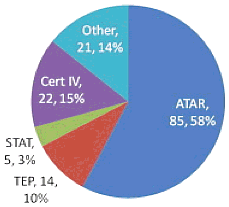
Figure 1: Demographic data for students entering Health Sciences courses at UNDA in Semester one 2011
Most students who entered the University via a secondary school entry pathway (n=85) had studied a mathematics subject at year 12 (82%) (Figure 2) but almost half of these students had only studied mathematics as a Stage 1 or Stage 2 subject (51%). Furthermore, in semester one 2012, 45% of students had studied mathematics at Stage 1 or 2 (data not shown). In 2011 just 2/49 (4%) of the students who studied Stage 1 or Stage 2 mathematics met the benchmark score of 65% in the PENA test (Figure 3). These results highlight that the majority of students studying Stage 1 or Stage 2 mathematics at secondary school do not acquire or retain the knowledge of the fundamental numeracy skills by the time they leave secondary school. Equally concerning was the observation that just 6/19 (32%) of students who studied Mathematics 3AB at year 12 achieved the benchmark score of 65% (Figure 3). There were 9 students in the first year cohort who studied Mathematics 3CD at year 12 and 2/9 (22%) students failed to reach the benchmark (Figure 3).
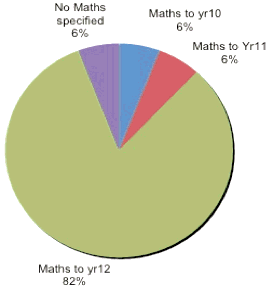
Figure 2: Information on the stage of mathematics studied at secondary school by first year
health sciences students(data were collected from the PENA study with n = 165 students)
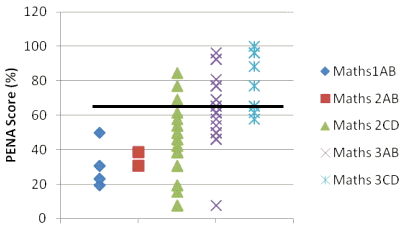
Figure 3: Comparison of PENA results with stage of secondary mathematics education
Each symbol represents the score obtained by a single student. The data were plotted for the number of students who studied Stage 1, Stage 2 or Stage 3 Mathematics. The solid line indicates the benchmark score of 65%.
A concerning behavioural trait displayed by health science students is their reluctance to seek academic support even when they are made aware of skill deficiencies. In semester one 2011, 91 students were identified as below the benchmark score in PENA, but this increased to 94 students in semester one 2012. In semester one 2011, there were no specific mathematics support course offered to students through the Academic Enabling Support Centre (AESC) at UNDA, but it was also noted that none of the "at risk" students attended the AESC to seek academic support for numeracy skills. To circumvent this problem, the AESC developed a Health Sciences specific mathematics support course that was offered during the semester break in 2012. There were 94 students identified as being below the benchmark in PENA during semester one 2012 and only 4 students (4/94 = 4%) enrolled in the mathematics support course. Therefore 96% of first year students identified as needing academic support in mathematics did not see the value of seeking support, despite being made aware of their skill deficiency at the start of semester one, and moreover that requirements for mathematical knowledge are embedded in units throughout their course.
Students who complete a Certificate IV meet the minimal University entry requirement for an undergraduate Bachelor degree course. In semester one 2011, 15% of first year students entered Health Science courses via the Certificate IV pathway. The data in Figure 4 highlight that none of the 17 Certificate IV students, irrespective of gender, achieved the benchmark score in the PENA test. These students are at a strong disadvantage with respect to their mathematics skills compared to students who complete mathematics at year 12.
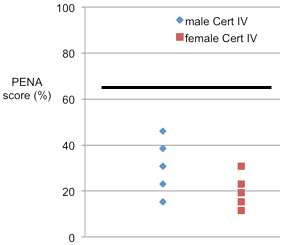
Figure 4: Comparison of PENA scores for male and female students entering via
Certificate IV.
The scores of n = 8 males and n = 9 females are shown.
To identify which of the fundamental skills most first year health science students were deficient in, we examined the frequency of correct scores for each question of the PENA tests that were completed in semester one 2011 and semester one 2012. As shown in Table 1 the key skills where less than 50% of students gave correct answers were in the topic areas of metric conversion, addition of fractions, calculation of indices, probability, basic trigonometry, and combined averages.
| Question topic | Semester 1, 2012 (n=166) | Semester 1, 2011 (n=168) |
| Q1: Metric conversion - length | 48% | 45% |
| Q2: Metric conversion - liquid | 42% | 69% |
| Q3: Addition of fractions | 33% | 62% |
| Q4: Simple algebra | 68% | 85% |
| Q5: Calculation of indices | 27% | 47% |
| Q6: % - finding a missing percentage | 81% | 88% |
| Q7: Probability | 7% | 17% |
| Q8: Graphical interpretation | 60% | 81% |
| Q9: Basic trigonometry | 32% | 61% |
| Q10: Combined averages | 11% | 36% |
Next we wanted to ascertain whether poor performance in the PENA would equate with a low final grade in a semester-long undergraduate mathematics unit. First year Health Sciences students can choose the Foundation of Mathematics unit, SM130, as an elective in their second semester, but enrolment in the unit is compulsory for students who had not completed Stage 3 mathematics at secondary school. The unit outcomes and the subject topics of the SM130 unit are outlined in Appendix 2. The unit is designed to reinforce mathematical concepts taught up to year 11 and 12 at secondary school. There were 19 students who enrolled in the SM130 unit in semester two 2011 who had completed the PENA test in semester one 2011. Only one student achieved the benchmark score in the PENA and completed the SM130 unit with a Pass Grade (a score of 52%). Of the remaining 18 students all had scored below the benchmark in the PENA and 16/18 students (89%) failed the unit (range of scores 10-42%), but there were two students who passed the SM130 unit with final grades of 50% and 54%.
There were 10 mid-year entry students who commenced their Health Sciences course in semester two 2011, had completed the PENA test as part of their enrolment in the CO115 unit, and were also enrolled in the SM130 unit. Of these 10 students only one achieved the benchmark score in the PENA and went on to achieve a pass grade in SM130 (score of 52%). There were 4/9 students who scored below the benchmark but managed to obtain a final pass grade in SM130 (range of scores: 50-66). The remaining 5 students failed the SM130 unit (range of scores: 10-44%). Thus, taken together from a total of 29 students over two semesters, just 2/29 (7%) achieved the benchmark score in the PENA and managed to pass the SM130 unit. There were 21/29 (72%) who were below the benchmark score in PENA and subsequently failed the SM130 unit. There were 6/29 (21%) students who were below the benchmark score in the PENA, but went onto pass the SM130 unit.
To determine whether the PENA test could predict successfully the final grade obtained by a student in the semester long mathematics unit, SM130, we tracked the final grades of students in the SM130 unit for those that had completed the PENA test in the CO115 unit in semester one 2011 and 2012. The data shown in Figure 5 shows that over the last 2 years, the PENA score was about 70% accurate in correctly predicting whether or not that student would pass or fail the SM130 unit. On average, 10% of students scored lower in PENA but passed the SM130 unit, though notably these students only achieved a low pass grade (scores 50-56). Also, we have found that in the last 2 years there were about 10% of students who scored above the benchmark in PENA but went on to fail the SM130 unit in semester two. Therefore, taken together these data suggest that PENA test was a reliable predictor of a student's mathematical ability and whether or not they would struggle with a tertiary level mathematics unit.
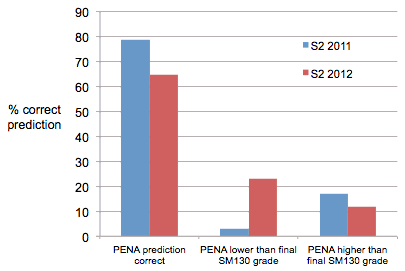
Figure 5: Reliability of the PENA score to predict a student's final grade in the SM130 unit
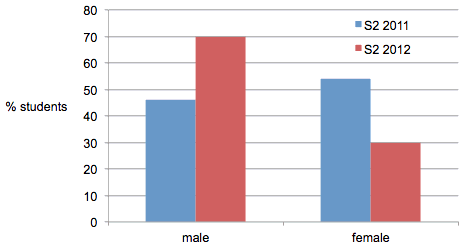
Figure 6: Gender of "at risk" students failing SM130 unit
Previous research by McNaught and colleagues identified male Health Sciences students, in particular those from a Certificate IV entry pathway, as being at a particularly high risk of failing one or more units in their first year at university (McNaught & McIntyre, 2011). We examined the gender distribution of those Health Sciences students who (i) failed the SM130 unit in semester two 2011 and 2012 and (ii) were identified as being below the benchmark score in PENA. Figure 6 shows that in 2011 there was an equal distribution of male and female students who failed the SM130 unit and who were below the benchmark score in PENA, but in semester two 2012, 70% of the students who failed SM130 and who were below the benchmark score in PENA were males.
At UNDA, a Health Sciences undergraduate degree consists of 24-30 units of study that may include none, one or two mathematics units. Mathematics is however, an inherent part of many Health Sciences courses. For example, in biomedical science units such as microbiology, biochemistry and physiology, students are required to carry out relatively complex mathematics, e.g. performing dilutions, calculating molarity, working with scientific notation and performing metric conversions. All these skills should be performed without the need for a calculator. Measurement of cell density is a more complex procedure that would require the help of a calculator. Biomechanics is a core unit within Exercise and Sports Science that requires a prerequisite knowledge of trigonometry and algebra as well principles of physics. To conduct fitness appraisals or to calculate an individual's body mass index requires a range of basic mathematical skills. In outdoor recreation, students may be required to calculate areas or volumes or to estimate distances for a specific trek. Likewise, a student in Preventive Health (Health Promotion) may be required to analyse demographic or statistical data. Helping students understand that mathematics is pervasive within all their units of study presents a significant problem for staff working with prospective health science students. Many express surprise that mathematics knowledge, skills and understandings are paramount to their course progress. Many of the skills, knowledge and concepts developed through upper school mathematics courses are not related to explicit numeracy outcomes. For example, mathematics courses develop analytical skills through problem solving and reasoning activities. They develop both deductive and inductive thinking skills. Therefore, much of the skill range that a student has from completing mathematics is not necessarily pure mathematics and remains broadly applicable to other learning areas in science.
Until recent years, universities established largely inflexible prerequisites as entry points into all courses of study. Traditionally, students who enrolled in a Bachelor of Biomedical Science at university would have completed a specified level of mathematics, and at least chemistry, as prerequisites for entry. This has changed dramatically in Australia, and the focus now is almost exclusively on a student's entry score, i.e. their ATAR ranking. It is understandable that schools focus students on maximising their ATAR score, and subject selections to achieve that goal, even if this is not in a student's best educational interests. For example, a 2012 UNDA entrant to the Bachelor of Exercise and Sport Science had an ATAR score of 87; however the student achieved this through a combination of courses in English, media, dance and geography. The student had completed no mathematics and no science courses through Years 11 and 12. Whilst the student had a high ATAR, she is likely to lack the prior knowledge that would be expected for a student entering the degree. We have noted from our demographic data collected at the time of enrolment that an increasing number of students who enter Health Sciences courses choose human biology without any other science unit at Year 11 and 12 at secondary school. Therefore, more students are avoiding the traditional mathematics and science subjects, such as physics and chemistry, at secondary school despite being destined for a career in a health sciences discipline.
Some universities have addressed the lack of prerequisites by having a list of 'recommended subjects'; this becomes problematic as there is no definitive requirement. Accordingly, a list of recommended subjects might alert a student that they will be advantaged by having such; however, it also implies that these subjects are not essential. Likewise, with many students unclear on their future study directions when they select their upper school courses, it may well be 'too late' to complete a recommended or required subject, regardless of the students' capacity to complete such. If students have been encouraged to undertake the subjects 'at the highest level' that they can manage, this is seldom a problem. It is a problem, however, in a model where schools attempt to have students maximise their ATAR score, by taking lower stage ('easier') courses to ensure high marks. For example, if a student is capable of completing chemistry but is dissuaded from doing so, and takes geography instead, it may well assist in terms of ATAR, but limit their course options or success in post-secondary schooling. Schools also inform students that universities offer short courses, or alternative units, to address a lack of prerequisites, as though this is a desirable option, rather than a fallback position. It is essential that UNDA establish prerequisites, and meaningful recommended subjects, in order to communicate clearly to secondary school students, that certain pathways are distinctly advantageous. Recognising that students might not appreciate the value of certain subjects to their degree (e.g. the importance of at least some mathematics to a health sciences course), better communication with future course entrants and to staff in secondary schools who regularly provide such information, is essential.
The University of Notre Dame's Fremantle campus, via the AESC has created a range of short, intensive teaching focused, 'primer' courses, offered prior to the commencement of semester, predominantly for new incoming students. These courses include academic reading and writing, mathematics, information technology and human biology as well as specific courses for students who are entering from a mature-age background, and from a Certificate IV pathway. Whilst these primer courses are useful for a wide range of reasons, they are not a panacea for students having inadequate preparation through high school. Health sciences students are the least likely of students to engage with academic support services, even despite being told they are deficient in key academic skills such as literacy and numeracy (McNaught & Hoyne 2011, McNaught & McIntyre 2011). An initial point of intervention begins at the time of a student's application to UNDA. All new students are interviewed by staff and it is at this point that students are told that any offer to their course is conditional upon them attending a specific primer course if they have not studied mathematics or science (e.g. human biology) to stage 3 at year 12.
It is a particular concern that in the testing completed as part of the PENA in semesters one and two of 2011, students who had completed the relatively complex course of Mathematics 3AB, as determined by the Western Australian Curriculum Council, performed so poorly within what was essentially a simple mathematics test. It was not expected that a student who had completed a 'higher level' course (in this case Mathematics 3AB at Year 12) at secondary school would have demonstrated such inadequate skills and knowledge. Discussions with these students indicate that the use of calculators is a central issue, and whether there is appropriate division within the course between calculator and non-calculator content. Whilst there is clearly a place for the use of calculators with complex work, if a student cannot complete rudimentary calculations without a calculator, (e.g. working with proportions and fractions and the use of basic algebra) the issue warrants more extensive investigation. Our data has shown that recent high school graduates are deficient in many key fundamental skills such as metric conversion, addition of fractions and basic trigonometry which are all taught from a primary school level and seem not to be reinforced while the students are at high school. This is another area that warrants a discussion between curriculum managers of secondary education and tertiary providers in order to clearly communicate the basic numeracy skills that must be attained by year12 to prepare students for tertiary study. Universities must apply more specific prerequisite subjects for science based courses. This would provide clear advice to secondary schools and students in year 11 and 12 that there are specific requirements before they can enter university.
Chanock, K. (2005). The John Grierson Keynote: Critiquing and reflecting. In Refereed Proceedings from the National Biennial Conference, ANU, Canberra, pp. 11-19. http://aall.org.au/sites/default/files/las2005/chanock.pdf
Ginsburg, H. (1997). Mathematics learning disabilities: A view from developmental psychology. Journal of Learning Disabilities, 30(1), 20-33. http://dx.doi.org/10.1177/002221949703000102
Hall, J. & Ponton, M. (2005). Mathematics self-efficacy of college freshmen. Journal of Developmental Education, 28(3), 26-33.
Harris, A. & Ashton, J. (2011). Integrating academic and language skills within management units. In Developing student skills for the next decade. Proceedings of the 20th Annual Teaching Learning Forum, 1-2 February 2011. Perth: Edith Cowan University. http://otl.curtin.edu.au/professional_development/conferences/tlf/tlf2011/refereed/harris.html
Koenig, K., Schen, M., Edwards, M. & Bao, L. (2012). Addressing STEM retention through a scientific thought and methods course. Journal of College Science Teaching, 41(4), 23-29. http://learningcenter.nsta.org/product_detail.aspx?id=10.2505/4/jcst12_041_04_23
McNaught, K. & Hoyne, G. (2011). Mathematics for first year success. In Proceedings of the 14th Pacific Rim First Year in Higher Education Conference, 29 June-1 July, Fremantle. http://fyhe.com.au/past_papers/papers11/FYHE-2011/content/pdf/4F.pdf
McNaught, K. & McIntyre, F. (2011). When a pass is not a pass. Journal of Academic Language and Learning, 5(1), A100-A109. http://journal.aall.org.au/index.php/jall/article/download/126/97
Mendick, H. (2005). A beautiful myth? The gendering of being/doing 'good at maths'. Gender and Education, 17(2), 89-105. http://dx.doi.org/10.1080/0954025042000301465
Murray, N. (2011). University post-enrolment English language assessment: A consideration of the issues. ERGO, 2(1), 27-33. http://www.adelaide.edu.au/herga/ergo/0201/ergo_v2n1_p27-33.pdf
Noss, R. & Hoyles, C. (1996). Windows on mathematical meanings: Learning cultures and computers. Dordrecht: Kluwer.
Parsons, S. & Bynner, J. (2005). Does numeracy matter more? London: Institute of Education.
Peach, D. (2005). Ensuring student success - the role of support services in improving the quality of the student learning experience. Studies in Learning, Evaluation, Innovation and Development, 2(3), 1-15. http://sleid.cqu.edu.au/include/getdoc.php?id=336&article=69&mode=pdf
Scutter, S., Palmer, E., Luzeckyj, A., Burke da Silva, K. & Brinkworth, R. (2011). What do commencing undergraduate students expect from first year university? The International Journal of the First Year in Higher Education, 2(1), 8-20. https://fyhejournal.com/article/viewFile/54/80
Skalicky, J., Adam, A., Brown, N., Caney, A. & Lejda, A. (2010). Tertiary numeracy enquiry. Centre for the Advancement of Learning and Teaching (CALT), University of Tasmania. http://ecite.utas.edu.au/75821
Thomson, S. & Hillman, K. (2010). Against the odds: Influences on the post-school success of 'low performers'. Adelaide: National Centre for Vocational Education Research. http://www.ncver.edu.au/lsay_pubs/research/LSAY_2285.pdf
Vogler, K. & Burton, M. (2010). Mathematics teachers' instructional practices in an era of high-stakes testing. School Science and Mathematics, 110(5), 247-261. http://dx.doi.org/10.1111/j.1949-8594.2010.00032.x
Waycaster, P. (2001). Factors impacting success in community college developmental mathematics courses and subsequent courses. Community College Journal of Research and Practice, 25(5-6), 403-416. http://dx.doi.org/10.1080/106689201750192256
| 2 | + | 3 |
| 3 | 4 |
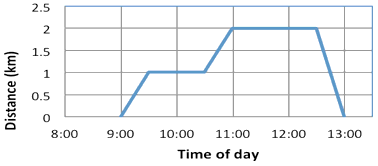
How far is it from Jan's house to the shop? Answer: ________ kilometres
How far is it from Jan's house to her friend's? Answer: _______ kilometres
How long did Jan spend at the shops? Answer: ________ minutes
How long did Jan spend at her friend's house? Answer _______ minutes
How long did the trip take altogether? Your answer: _________hours
The articles in this Special issue, Teaching and learning in higher education: Western Australia's TL Forum, were invited from the peer-reviewed full papers accepted for the Forum, and were subjected to a further peer review process conducted by the Editorial Subcommittee for the Special issue. Authors accepted for the Special issue were given options to make minor or major revisions (minor additions in the case of McNaught and Hoyne). The reference for the Forum version of their article is:
McNaught, K. & Hoyne, G. (2013). Testing program reveals deficient mathematics for health science students commencing university. In Design, develop, evaluate: The core of the learning environment. Proceedings of the 22nd Annual Teaching Learning Forum, 7-8 February 2013. Perth: Murdoch University. http://ctl.curtin.edu.au/professional_development/conferences/tlf/tlf2013/refereed/mcnaught.htmlAuthors: Professor Keith McNaught is Director of the Academic Enabling and Support Centre, University of Notre Dame Australia, working between the Fremantle and Broome campuses. Keith's long teaching career has involved primary, secondary, tertiary, and specialist teacher roles. He specialised in mathematics education for several years completing doctoral studies on mathematics anxiety. Email: keith.mcnaught@nd.edu.au Web: http://www.nd.edu.au/academic_support/staff/kmcnaught.shtml Associate Professor Gerard Hoyne is Associate Dean in the School of Health Sciences, University of Notre Dame Australia, Fremantle Campus. Gerard has been involved in medical research for over 20 years and over the last 3 years has been responsible for teaching undergraduate and postgraduate students in biomedical science. Email: gerard.hoyne@nd.edu.au Web: http://www.nd.edu.au/fremantle/schools/health/staff/ghoyne.shtml Please cite as: McNaught, K. & Hoyne, G. (2013). Testing program reveals deficient mathematics for health science students commencing university. In Special issue: Teaching and learning in higher education: Western Australia's TL Forum. Issues in Educational Research, 23(2), 180-195. http://www.iier.org.au/iier23/mcnaught.html |